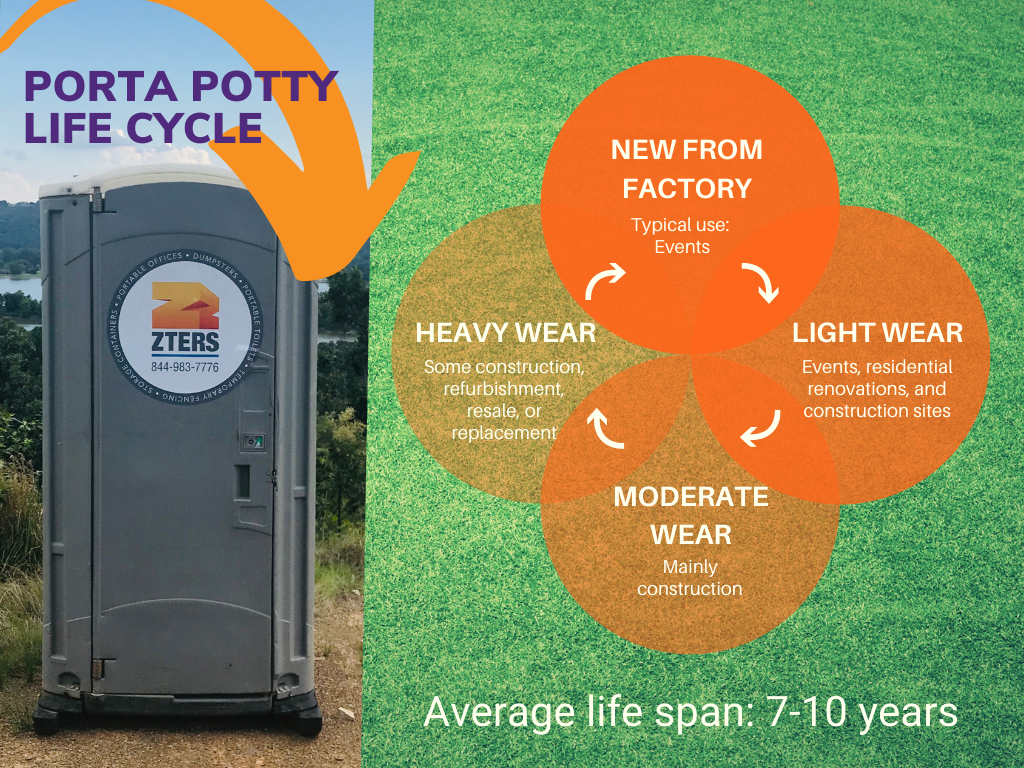What’s the life cycle of a porta potty?
POSTED ON July 17, 2020 | BY Angela Phillips
The average lifespan of a porta potty is around 10 years, and a lot can happen in that decade. There are many types of portable toilets and they’ve come a long way since the first porta potty models. Just a few include luxury trailers, toilets with baby changing tables, Americans with Disabilities Act (ADA) compliant toilets, and more. Some units (trailers, for example) are built for custom purposes with a limited lifespan. But the vast majority are durable polyethylene units that are made to stand up to years of use.
So, what’s the life cycle of a porta potty?
Stages: the life cycle of a porta potty
Heavy-duty plastic construction and water-saving technology means porta potties only need to be serviced every 200 uses or so. These stages are a general rule of thumb. The number of people using the unit and the amount of time it spends being hauled from location to location can put extra wear on units over time.
New from factory
When these sparkling clean units come off the factory floor, they’re generally reserved for special events. Brand new units will usually feature the latest technologies. For example, new solar panel restrooms look and feel more like a regular restroom rather than a traditional porta potty.
New units are more expensive for porta potty vendors to purchase, so they may be in limited supply. This largely depends on your location. In rural areas or areas where there isn’t much demand for portable toilets, it may be more difficult to find brand new units. On the other hand, there are events vendors that specialize in upscale events. They’ll have access to the newest event porta potty models and features, and they may be willing to deliver outside their normal service area.
Light wear
New toilets can be like new cars. When newer models and technologies are released, older units move down a tier. No longer new, but not yet old, these “light wear” porta potties are often used at events and construction sites. They may not be the latest and greatest, but these are clean units in good repair.
This is the most common grade of portable toilet you’ll see on worksites and events where many toilets are needed. Fun runs, festivals, and events where large crowds are gathered will likely have many rows of these toilets available.
Moderate wear
If you’ve ever stepped into a portable toilet that has seen better days, maybe at a carnival or state fair, then you’ve been inside a unit that’s reached the midpoint of its life cycle. These units are still clean and functional, but they probably show signs of having been hauled around a lot and maybe even tipped, dragged, dented, or tagged here and there. Scratches and dents are pretty typical. And they probably look pretty dated as well.
You will definitely find these on many construction sites. Demolition sites, in particular, may opt for these older porta potties because it won’t be a complete loss if the unit is damaged or unintentionally destroyed. While these units are still sanitary and safe to use, they may not be great to look at. (Luckily polyethylene doesn’t hold odors, so they shouldn’t smell!)
Heavy wear
The last stage of the game for porta potties is when they’ve had so much wear and tear that they need to be replaced. This may include damage caused by accidents or general wear and tear. The plastics and parts used in porta potty manufacturing are designed to last longer than their typical 10-year life cycle, but after a decade most portable toilets do show their age. Especially if they’ve been dragged around construction sites.
Restroom trailers and custom units that don’t get a lot of use each year could last much longer than a decade. But for everyday porta potties, all the moving around and servicing will add up to more wear in a shorter amount of time. Toilets at the end of their life cycle may be resold to private parties or dismantled to be properly destroyed.
So, where will your rental fall in the life cycle of a porta potty? When you’re renting portable toilets for events, construction sites, emergency use, or even home improvement DIY projects, it will almost always be in the light to moderate wear category. That may vary by location and demand at the time. When in doubt, give us a call! We’ll help you find the right portable toilets for your project.
